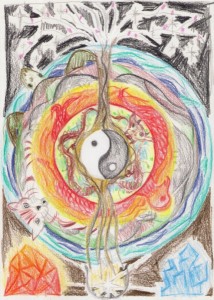Evolutionary Spirtuality, or the idea of Conscious Evolution is one of the most exciting and cutting edge areas that is being explored in spirituality today. Luminaries include people such as Barbara Marx Hubbard, Andrew Cohen and Craig Hamilton.
This week’s article is a short contemplation on learning to identify your own Evolutionary Self and distinguish it from your biological self. Enjoy!
Yours in the spirit of the evolving universe,
Toby
Meditating on The Difference Between Your Evolving Self and Your Biological Self
In this article I want to draw a distinction between two aspects of self that are often placed together, but are in fact very different. What I will do is define them both first, then explain how to begin working with the Evolutionary Self effectively in daily life.
The Biological Self is the sense of self that we have that is based around our biological programming. This programming is very ancient, and primarily works of past patterns that have evolved over thousands of years. Its needs are primarily based around survival/fight or flight, and it almost exclusively looks to the past for its inspiration. It sees patterns that have worked to fulfill our survival needs in the past, and it seeks to mimic them in our current behaviors. It works out of areas of the brain that are very ancient, and exerts a tremendous influence on our lives. It can be a very good and able servant to us, but if we allow it to be our master then it will lead us along a very limited life path, based around patterns of consciousness that are essentially survival based and aimed at staying in our comfort zone.
Our Evolutionary or Evolving Self is that part of cosmic evolutionary consciousness that is embodied within us. You could say that it is that part of evolution (as in the 13.5 billion year process that began with the Big Bang) that is becoming conscious of itself through us as an individualized human. Our evolutionary self is focused on the future, on becoming, on creating the new, on innovating. The Evolving Self is uninhibited by past patterns of biology and of ego and feels exited and motivated to make our life and life on earth fulfill as much of its potential as possible. The Evolving Self is naturally a good leader, and placing it in the forefront of our awareness enables us to lead other parts of our self and ego int the future without being inhibited by our “past baggage”. The Evolving Self is always looking to reach its highest potential, and to make the biggest and most meaningful contribution to the evolution of the Planet and of humanity that it can.
Our Evolving Self embodies the energy of evolution itself and seeks to catalyze conscious evolution in all situations.
Starting to connect and work with your Evolving Self
Imagine the Big Bang 13.5 million years ago: From out of nothingness an immense explosion of matter, energy and consciousness that gradually transforms over time into our present Universe.
See it continuing to evolve now in our present Universe, in our Planet, and in you, in the core of your own consciousness and being.
Feel within you now the momentum of that cosmic drive toward evolving the new, a dynamic spark of light within you that is focused the future, on becoming, on creating a better and greater life and world.
Once you have felt your Evolving Self within you, as yourself the question “What is my Evolving Self asking of me right now, today, in this moment?”
After you have finished your contemplation, write down the ideas that came to you try and isolate one action that you can do today, or this week that will be a direct expression of your Evolutionary Self.
In general, whenever you are faced with a challenge in your life, ask yourself the question “What is my Evolving Self encouraging me to do here?”







